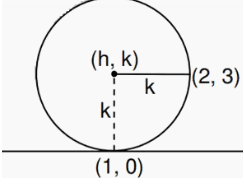PROBLEMS ON CIRCLES IN CONIC SECTIONS
Problem 1 :
The equation of the circle passing through (1, 5) and (4, 1) and touching y-axis is
x2 + y2 - 5x - 6y + 9 +λ(4x+3y-19) = 0
where λ is equal to
a) 0, -40/9 b) 0 3) 40/9 d) -40/9
Solution :
x2 + y2 - 5x - 6y + 9 +λ(4x+3y-19) = 0
x2+ y2 - 5x + 4λx - 6y + 3λy+ 9 -19λ = 0
x2+ y2 + (4λ - 5)x + (3λ - 6)y + 9 -19λ = 0
The circle touches y-axis, then x = 0
y2 + (3λ - 6)y + 9 -19λ = 0
Since the circle touches y-axis, it will have equal real roots.
b2 - 4ac = 0
(3λ - 6)2 - 4(1)(9 -19λ) = 0
Option a :
λ = 0 and λ = -40/9
these are the values satisfying the equation. So, option a is correct.
Problem 2 :
The circle x2 + y2 = 4x + 8y + 5 intersects the line 3x - 4y = m at two distinct points if
a) 15 < m < 65 b) 35 < m < 85
3) -85 < m < -35 d) -35 < m < 15
Solution :
x2 + y2 = 4x + 8y + 5
x2 + y2 - 4x - 8y - 5 = 0
Comparing the equation with x2 + y2 + 2gx + 2fy + c = 0
2g = -4, 2f = -8
g = -2, f = -4, c = -5
Center of the circle will be (-g, -f) ==> (2, 4)
radius = √g2+f2-c
= √22+42-(-5)
= √4+16+5
= 5
Length of perpendicular from the point (2, 4) will be lesser than the radius.
So, option d is correct.
Problem 3 :
The length of the diameter of the circle which touches the x-axis at the point (1, 0) and passes through the point (2, 3).
Solution :
Let (h, k) be the center of the circle and r be the radius.
(x - h)2 + (y - k)2 = r
The circle is passing through the point (1, 0).

The vertical distance between (1, 0) to the center is k. Then the distance between (h, k) and (2, 3) will be the same because they are radii.
(1 - h)2 + (0 - k)2 = k2
(1 - h)2 = 0
1 - h = 0
h = 1
The circle passes through the point (2, 3).
(2 - h)2 + (3 - k)2 = r
Applying the value of h
(2 - 1)2 + (3 - k)2 = k2
1 + 9 - 6k + k2 = k2
-6k = -10
k = 10/6
k = 5/3
Problem 4 :
The radius of the circle 3x2 + by2 + 4bx - 6by + b2 = 0
a) 1 b) 3 c) √10 d) √11
Solution :
3x2 + by2 + 4bx - 6by + b2 = 0
If the given equation represents equation of circle then, it will have the following characteristics.
i) it is a second degree equation in x and y.
ii) Coefficient of x2 = coefficient of y2
iii) Coefficient of xy = 0
Using the second property, b = 3.
3x2 + 3y2 + 12x - 18y + 9 = 0
Dividing by 3, we get
x2 + y2 + 4x - 6y + 3 = 0
2g = 4 ==> g = 2
2f = -6 ==> f = -3
and c = 3
Finally g = 2, f = -3 and c = 3
radius = √g2 + f2 - c
= √22 + (-3)2 - 3
= √4 + 9 - 3
= √10
Kindly mail your feedback to v4formath@gmail.com
We always appreciate your feedback.
©All rights reserved. onlinemath4all.com
Recent Articles
-
Digital SAT Math Problems and Solutions (Part - 150)
Apr 25, 25 11:46 AM
Digital SAT Math Problems and Solutions (Part - 150) -
AP Calculus AB Problems with Solutions (Part - 19)
Apr 24, 25 11:10 PM
AP Calculus AB Problems with Solutions (Part - 19) -
AP Calculus AB Problems with Solutions (Part - 18)
Apr 24, 25 11:06 PM
AP Calculus AB Problems with Solutions (Part - 18)
